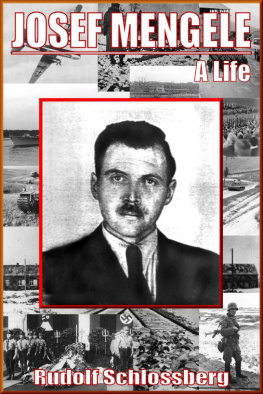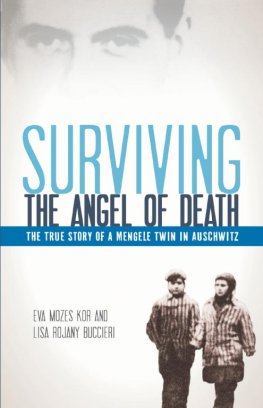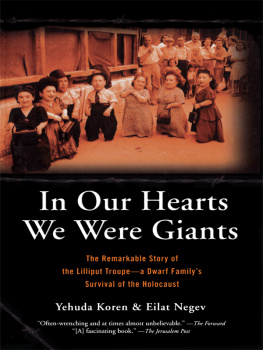JOSEF MENGELE
A LIFE
By Rudolf Schlossberg
Copyright 2012 Rudolf Schlossberg - SmashwordsEdition
Medicine and war
Josef Mengele was a German doctor,infamous for carrying out experimentation on unwillingconcentration camp inmates during World War II.
He was born in Gnzburg on March 16,1911, as the youngest of of the three sons of Karl and WalburgaMengele. His parents had bought a a firm that manufacturedagricultural equipment a few years prior to his birth, and hadadvanced to being the largest employer in the area in a short time.Karl Mengele&Sons employed over 2000 people by the time ofKarls death in 1959. Karl fought in World War I, and joinedvarious nationalist-oriented organizations during the 1920s, andalthough he is described as a conservative character there are noindications that he was an anti-Semite. He ran without success fora seat on the Gnzburg city council in 1924 and 1929. In 1932 helet Adolf Hitler use one of his factory halls during the lattersown election campaign, and joined the NSDAP (Hitlers party) in1933. After a donation to the party he was made in return a citycouncillor, but when rumors began to spread within the party thathe had bought his seat on the council he also joined theSS.
Josef Mengele himself became amember of the Grodeutschen Jugendbund, a nationalist youthorganization with an anti-Semitic worldview.
In spite of all this, historianstend to agree that neither Mengele was particularly inclined tohate Jews; their background and views could more accurately bedescribed as catholic-conservative and nationalist.
In 1930, Josef Mengele joined MunichUniversity to study medicine. Except for stints in Bonn (because ofa girl) and Vienna, he spent all of his semesters in Munich,finishing his studies in 1935. He had also signed up to studyanthropology in 1933, and his doctoral thesis of 1935 is thustitled Rassnemorphologische Untersuchung des vorderenUnterkieferabschnitts bei vier rassischen Gruppen, a study of theanthropological qualities of the lower jawbone of four differentraces. For this, he studied the jawbones of 123 specimens in theMunich Anthropolocial State Collection, in order to further histheory that the shape of the jaw would prove conclusively to whichrace the specimen belonged. He obtained the highest grade possiblefrom the director of the Munich Institute for Anthropology,Professor Theodor Mollison; but todays scientists, such as UdoBenzenhfer, qualify this research as being more delusion thanscience.
In the summer of 1936, Mengeleobtained a license to practice medicine, and spent four months atthe childrens clinic of Leipzig University. At Morrisons behest,he then joined the University Institute for Biology and RacialHygiene of Frankfurt am Main, which was being led by Otmar Freiherrvon Verschuer. Mollison and Verschuer are seen as being responsiblefor Mengeles interest in problems of racial hygiene.
Verschuer in particular wasimportant to Mengeles future career: he had made his name withstudies about genetics, especially involving twins. Verschuer onlyjoined the NSDAP in 1940, but was always an ardent supporter ofnationalist racial theories. He even worked with the Nazi regime onits policy of forced sterilizations of inferior races, andparticipated as an expert witness in trials of race defilers(people who had had sex with someone from another race, such asJews or Gypsies). Mengele, who was described as Verschuersfavorite student after the war by his colleague Hans Grebe,participated in these activities.
Mengele obtained a s second doctortitle with a study of the genetic inheritance of people with acleft upper lip. He wanted to prove that such a defect isinheritable, but his study is invalid. He began by investigatingthe families of people who had been operated because of their cleftupper lips, and then declared a 100 percent success rate of hisgenetic inheritance predictions, since the relatives he visited(over 500) had micromanifestations. He lowered his estimates inhis final results tally, but even so, it is not certain whether anyof these micromanifestations were manifestations of a cleft upperlip or not.
Mengele was stripped of both of hisdoctor titles in 1960 and 1961, because of his experiments atAuschwitz.
As a student, Mengele had joined theStahlhelm, a paramilitary organization with strong nationalistleanings. In 1934, a year after Hitlers coming to power, theStahlhelm (steel helmet) was integrated into the SA(Sturm-Abteilung, storm division, the Nazis own paramilitaryorganization), but Mengele was allowed to leave the SA due to akidney problem, from which he had been suffering since hisyouth.
In 1938, Mengele joined the NSDAP,and even signed up for the SS in the same year. Hans Mnch, acolleague of Mengeles in Auschwitz, said in 1985 that Mengele wasa cool-thinking career-minded opportunist, but was also politicallyconvinced [of National Socialism].
Mengele ran through an abbreviatedtraining program with the 19. Company of the 137. Mountain CombatRegiment, finishing after only three months on January 21, 1939. Hemarried Irene Schnbein that same year, but was refused an entryinto the Clan Book of the SS, because the ancestry of his wifesgreat-grandfather was unknown.
In June 1940, after the war hadbegun, he was transferred from his post at the Frankfurt Instituteto a combat medic unit in Kassel.
Complaining of mistreatment at thehands of an instructor, Mengele left his unit and instead joinedthe Waffen-SS, where he participated in a training course formedics. He was promoted from Hauptscharfhrer to the officer rankof Untersturmfhrer in September 1940. Mengele had also beenordered to join the offices for repatriation and immigration inLodz and Poznan, where he created racial-biological reports on thesuitability of ethnic Germans that wanted to move to Germanyproper.
Sometime between February and May1941, he became a field medic of the SS-Panzer Batallion Wiking.Mengele participated in the Russian campaign from the beginning;his presence at Dnipropetrovsk, where he met an old friend from hisuniversity days, proves this. The Wiking division participated inwar crimes, including a massacre of Jews in 1941.
Mengele received the Iron Cross inboth the first and second classes for his bravery in rescuingwounded comrades. He was also promoted toObersturmfhrer.
It is unknown how long exactly hespent fighting at the front; sources cannot agree on an exact date.He was ordered to take up a post at the Reichsarzt-SS office inJuly 1942, but his wife Irene as well as many of his comradesstated that he only left the front in January 1943, due to aninjury.
What is certain is that Mengelejoined the SS-Ersatzbatallion Ost in February 1943, where he waspromoted to Hauptsturmfhrer. On May 30, 1943, he began his serviceat the infamous Auschwitz concentration camp.
Auschwitz
At Auschwitz, Mengele was the headphysician of the gypsy camp, which was disbanded in August 1944.Also worked in different capacities at Birkenau concentration camp.His superior at Auschwitz was Eduard Wirths. Mengele left Auschwitzon January 18,1945, fleeing from the advancing Red Army.
It is unknown why exactly Mengelewas transferred to Auschwitz; some speculate that this was due toVerschuer wanting to have an ally in the camp who could provide himwith research material. Others say that Mengele volunteered forcamp duty rather than being sent back to the front. Mengele himselfstated that he saw great research opportunities at Auschwitz, andhe would in the future cooperate with the racial scientist KarinMagnussen, who was very interested in the eye colors of gypsy twinsat Auschwitz. Magnussen was known to Verschuer, and had sent himpictures of various people at the camp with different eye colors.Her main research subject at the time was the study of the impactthat genetics had on eye color; Mengele wold soon after his arrivalat the camp begin sending prepared eyeballs he had harvested fromhis patients to her for study.











